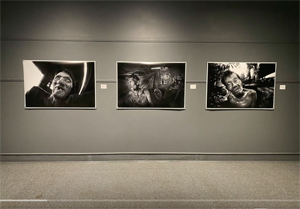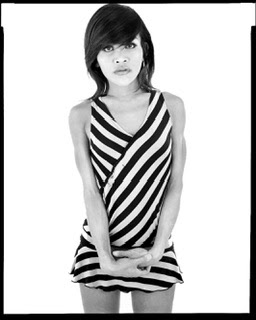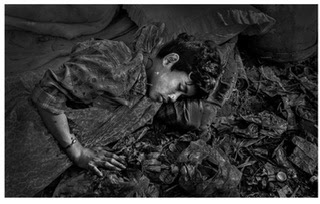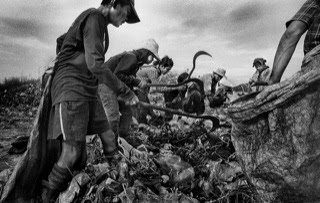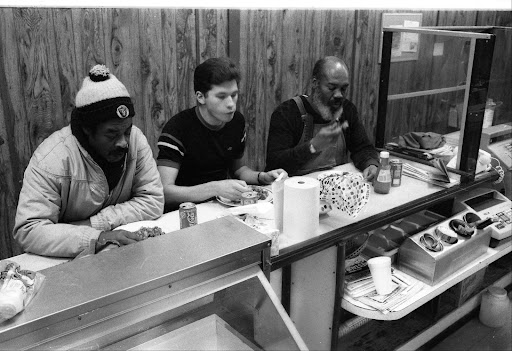
Last week, we profiled the work of the acclaimed New York photographer Diane Arbus. As a major retrospective of her work opens in London, Germaine Greer, who agreed to pose for Arbus in 1971, reveals what it was like to be under the glare of her lens ...
Saturday October 8, 2005
The Guardian
Visitor at the Diane Arbus: Revelations exhibition. Photograph: Jeff Chiu/AP
I first encountered Diane Arbus in April 1971 at a press conference organised by the American publishers of my book The Female Eunuch at Sardi's restaurant in New York. She was one of a number of photographers who asked me for a private sitting, and I didn't refuse. By May I had acquired a New York boyfriend, David, who urged me to let one of his friends photograph me. The friend was Diane Arbus.
I was photographed a lot in those days, and I hated the whole rigmarole so I tried to wriggle out of it. David, who was a photographer himself, had never wanted to photograph me. I wasn't his kind of subject. He earned his living as a taxi-driver, but what he worked at was taking candid photographs of New York street life with the Nikon he kept beside him on the front seat of his yellow cab. Arbus also worked as a street photographer, like the ones of the 1940s who used to snap people as they walked past and then run up and offer them a card, so they could buy the snapshot if they wanted to, except Arbus didn't offer her subjects a card and didn't let them see the pictures. You have only to look at the contact sheets included by her daughter Doon Arbus in Diane Arbus: Revelations to see the street photographer at work with her Rolleiflex and flash. A lot of nonsense is talked about Arbus's empathy with her subjects; what is mirrored on most of those faces is faint bewilderment and timid resentment. The subjects have no names because Arbus neither knew nor cared who they were.
I'm not sure whether David was on my side or whether he was more concerned to ingratiate himself with Arbus. He certainly knew her work, as I did not. Maybe he thought, after much lionising by the uptown set, I had it coming. He must have known that, as a photographer, Arbus had never allowed any of her subjects to look good. For the years that she worked with her husband, Alan Arbus, as the stylist for his glamour photographs she had had no option but to make beautiful people look more beautiful. It was said that she was the best stylist in the business. Once the marriage broke down and Arbus struck out on her own, there was to be no more making people look their best. Maybe David thought he would learn something by watching Arbus at work. If he did, he must have been disappointed because, as soon as they were both in my room in the Chelsea hotel, she ordered him to leave. She couldn't work with other people in the room.
She seemed too birdlike and delicate to be lugging her outsize camera bag on such a warm day. Her thin cheeks were red with exertion and her fine fairish hair stood out around her face in wisps. I asked her whether she would like a rest or refreshment or something of the sort, and she refused in a tiny voice, without looking up from her camera bag. I'd have liked something myself, but this seemed not to occur to her. Throughout the session she spoke very little and always in a deceptively apologetic murmur. She avoided facing me, as she ferretted in the big bag and patted her many pockets. She set up no lights, just pulled out her Rolleiflex, which was half as big as she was, checked the aperture and the exposure, and tested the flash. Then she asked me to lie on the bed, flat on my back on the shabby counterpane.
I did as I was told. Clutching the camera she climbed on to the bed and straddled me, moving up until she was kneeling with a knee on both sides of my chest. She held the Rolleiflex at waist height with the lens right in my face. She bent her head to look through the viewfinder on top of the camera, and waited. In her viewfinder I must have looked like a guppy or like one of the unfortunate babies into whose faces Arbus used to poke her lens so that their snotty tear-stained features filled her picture frame (eg, A Child Crying, NJ, 1967). I knew that at that distance anybody's face would have more pores than features. I was wearing no make-up and hadn't even had time to wash my face or comb my hair.
Pinned on the bed by her small body with the big camera in my face, I felt my claustrophobia kick in; my heart-rate accelerated and I began to wheeze. I understood that as soon as I exhibited any signs of distress, she would have her picture. She would have got behind the public persona of Life cover-girl Germaine Greer, the "sexy feminist that men like". I concentrated on breathing deeply and slowly, and keeping my face blank. If it was humanly possible I would stop my very pupils from dilating. Immobilised between her knees I denied her, for hour after hour. Arbus waited me out. Nothing would happen for minutes on end, until I sighed, or frowned, and then the flash would pop. After an eternity she climbed off me, put the camera back in her bag and buggered off. A few weeks later she took an overdose of barbiturates and slit her wrists.
According to John Szarkowski, then director of the Department of Photography at New York's Museum of Modern Art, "Her real subject is no less than the unique interior lives of those she photographed." As if you could penetrate the interior life of a stranger by kneeling astride her and shoving a lens up her nose. It's Szarkowski's kind of mindless nonsense about what Arbus was really up to that obscures her genuine achievement. Interior life is probably not any photographer's subject; it was certainly not hers. In Arbus's hands everyone is en travesti; even women appear as female impersonators. She may have thought she was getting the mask off, but what she was photographing was actually the clumsy ill-drawn mask itself.
Arbus has been credited with stunning originality in her daring choice of subject, as if the tradition of portraying freaks were not as old as photography. Her Three Russian Midget Friends In A Living Room On 100th St of 1963 treats the subject exactly the same way as hundreds of commercial photographers before her, perching the little people on full-size furniture so their feet hardly touch the floor. Her vision developed little between 1963 and 1970 when she treated A Jewish Giant At Home With His Parents In The Bronx in a very similar way, though this time she emphasised the giant's outline with the black shadow thrown by the flash. What her work does not show is compassion, which is something to be grateful for. If I'd thought Arbus felt compassion for me I'd have socked her.
Though formally Arbus is within the tradition of freak photography, there is an important difference between her and her predecessors like the Eisenmann Studio or Obermann and Kern. Their subjects had names, lots of them, stage names and real names. The giants, dwarves, midgets, conjoined twins, bird-girls, bearded women and dog-faced boys whose photographs appear on thousands of postcards were all professionals. Often the notes on the postcards spoke of them as well-educated and happily married. Arbus's nameless subjects are denied such confederacy and performativity. She often uses the devices of the older tradition in her treatment of otherwise unremarkable subjects. Her famous Identical Twins, Roselle, NJ of 1967 are posed as if they were joined at the shoulder and hip and had only three arms between them. She reduced her subjects to generic phenomena by the names she chose for them: Jewish Couple, Puerto Rican Housewife, Albino Sword-Swallower. My ordeal resulted in a picture called Feminist In Hotel Room. No permission for the reproduction of what is an undeniably bad picture was ever requested.
The language Arbus uses about her photographic practice is revealing: "Freaks was a thing I photographed a lot. It was one of the first things I photographed and it had a terrific kind of excitement for me. I just used to adore them. I still do adore some of them." "Freaks" (a word 21st-century sensibility finds hard to use) is "a thing", a medium for her use that Arbus finds quite distinct from herself. This insensibility Arbus shares with her contemporary and fellow New Yorker, Andy Warhol. Though he was happy to exploit a cast of exhibitionists in the multimedia freak show called the Factory, Warhol never regarded himself as one of them. Like Arbus he was outwardly practically mute, evasive and completely indecisive; inwardly he was ruthless.
The emotion that thrills through every Arbus icon making them haunting and unforgettable is a relentless, all-encompassing loathing. Nudist Lady With Swan Sunglasses, PA 1965 is a rather subtle case in point. The subject is a fair-skinned woman, not in the first flush of youth, with a perfectly proportioned body, carrying a towel. She is wearing nothing but a petalled bathing hat, elaborate swan-shaped sunglasses outlined in rhinestones, a locket and a watch. She stands in a timid parody of a model's pose, left hand on left hip, left heel raised. The skin of her thigh is mottled as if she is cold. Against the unrelievedly dark background she is as white as a maggot. I have seen photographs of maggots that have shown more fellow feeling. The pretty lady would have looked far less ridiculous if the picture had been called After The Swim or La Baigneuse or if Arbus had stopped it down a touch and relieved the harshness of the contrast.
To say that Arbus's creativity was driven by disgust is not to dismiss her as an artist. It is a curiously moralistic view of art that says it cannot be generated by negative emotion. Good haters can make good art, but their despair and indignation ought to be called forth by something more sinister than mere human imperfection and self-delusion. Arbus is not an artist who makes us see the world anew; she embeds us in our own limitations, our lack of empathy, our kneejerk reactions, our incuriosity and lack of concern. Hers is a world without horizons where there is no escape from self.










